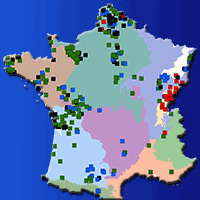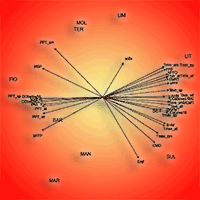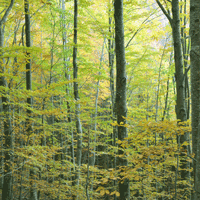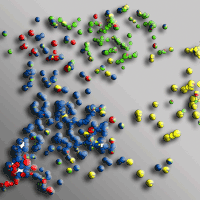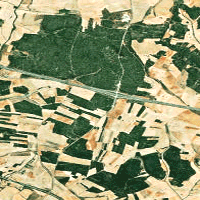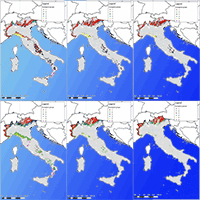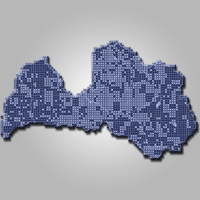
Genetic analysis of Latvian Salix alba L. and hybrid populations using nuclear and chloroplast DNA markers
Dainis Rungis , Maris Laivins, Agnese Gailite, Anna Korica, Dagnija Lazdina, Vilnis Skipars, Ilze Veinberga
iForest - Biogeosciences and Forestry, Volume 10, Issue 2, Pages 422-429 (2017)
doi: https://doi.org/10.3832/ifor2004-009
Published: Mar 24, 2017 - Copyright © 2017 SISEF
Research Articles
Abstract
Latvia is at the northern border of the species range of S. alba L. in Europe, and there has been some debate whether the Latvian populations of S. alba are autochthonous, as this species has long been planted in Latvia as an ornamental tree in gardens, parks and roadsides. In addition, there is increasing interest in the use of several Salix species (including S. alba) as bioenergy crops. Natural S. alba stands throughout Latvia, as well as stands of possibly hybrid origin were analysed using nuclear and chloroplast markers. Our results showed that S. alba populations are probably natural, and that the rate of vegetative reproduction is low, supporting the evidence that Latvia is within the natural range of S. alba. These results provide the basis for the identification of possibly introduced or artificially regenerated stands of S.alba in Latvia. In addition, our results confirm that S. alba hybridises with S. fragilis, and that natural stands including hybrid individuals can be established. The analysis of chloroplast markers indicated that the predominant hybridisation occurs by fertilisation of S. fragilis by S. alba pollen; however, the extent of haplotype sharing between these two species should be further investigated.
Keywords
Authors’ Info
Authors’ address
Maris Laivins
Agnese Gailite
Anna Korica
Dagnija Lazdina
Vilnis Skipars
Ilze Veinberga
Latvian State Forest Research Institute “Silava”, 111 Rigas st, Salaspils, LV-2169 (Latvia)
Corresponding author
Paper Info
Citation
Rungis D, Laivins M, Gailite A, Korica A, Lazdina D, Skipars V, Veinberga I (2017). Genetic analysis of Latvian Salix alba L. and hybrid populations using nuclear and chloroplast DNA markers. iForest 10: 422-429. - doi: 10.3832/ifor2004-009
Academic Editor
Fikret Isik
Paper history
Received: Feb 05, 2016
Accepted: Nov 27, 2016
First online: Mar 24, 2017
Publication Date: Apr 30, 2017
Publication Time: 3.90 months
Copyright Information
© SISEF - The Italian Society of Silviculture and Forest Ecology 2017
Open Access
This article is distributed under the terms of the Creative Commons Attribution-Non Commercial 4.0 International (https://creativecommons.org/licenses/by-nc/4.0/), which permits unrestricted use, distribution, and reproduction in any medium, provided you give appropriate credit to the original author(s) and the source, provide a link to the Creative Commons license, and indicate if changes were made.
Web Metrics
Breakdown by View Type
Article Usage
Total Article Views: 49458
(from publication date up to now)
Breakdown by View Type
HTML Page Views: 41471
Abstract Page Views: 3113
PDF Downloads: 3737
Citation/Reference Downloads: 23
XML Downloads: 1114
Web Metrics
Days since publication: 3191
Overall contacts: 49458
Avg. contacts per week: 108.49
Citation Metrics
Article Citations
Article citations are based on data periodically collected from the Clarivate Web of Science web site
(last update: Mar 2025)
Total number of cites (since 2017): 4
Average cites per year: 0.44
Publication Metrics
by Dimensions ©
Articles citing this article
List of the papers citing this article based on CrossRef Cited-by.
References
Linkage mapping in tetraploid willows: segregation of molecular markers and estimation of linkage phases support an allotetraploid structure for Salix alba × Salix fragilis interspecific hybrids. Heredity 90: 169-180.
CrossRef | Gscholar
Koki un krumi Latvijas lauku parkos [Trees and shrubs in Latvian countryside parks]. Zinatne, Riga, Latvia, pp. 346. [in Latvian]
Gscholar
Koku un krumu introdukcijas vestures, aklimatizacijas un naturalizacijas iss apskats [Short overview of tree and shrub introduction history, aclimatisation and naturalisation]. In: “Latvijas Geografu Kongresa Tezes” [Proceedings of the congress of Latvian geographers] (Krauklis A, Laivinš M, Gaija G, Škinkis P eds). Latvijas Universitate, Riga, Latvia, pp. 20-24. [in Latvian]
Gscholar
Salicaceae Mirbel. In: “Flora of the Baltic countries” (Laasimer L, Kuusk V, Tabaka L, Lekavičius A eds). Estonian Academy of Sciences, Institute of Zoology and Botany, Tartu, Estonia, pp. 158-174.
Gscholar
Baltais vitols Gaujas vidusteces rajona [White willow in the Gauja River basin]. Mežsaimnieciba un Mežrupnieciba 1: 15-17. [in Latvian]
Gscholar
Vitolu (Salix L.) gints Latvija [Willow (Salix L.) genus in Latvia]. DU BRIPI, Daugavpils, Latvia, pp. 100. [in Latvian]
Gscholar
Versuch einer Naturgeschichte von Livland [Attempt at a natural history of Livonia]. Verlag Johann Gottlieb Immanuel Breitkopf, Leipzig, Germany, pp. 390. [in German]
Gscholar
Atlas Flora Europaeae. Salicaceae to Balanophoraceae. Committee for mapping the flora of Europe and Societas Biologica Fennica Vanamo, Helsinki, Finland, vol. 3, pp. 128.
Gscholar
Die Holzgewächse von Est-, Liv-, und Curland [The woody plants of Estonia, Livonia and Courland]. Verlag von C. Mattisien, Dorpat, Germany, pp. 290. [in German]
Gscholar
Salix - Salicaceae. In: “Flora of the Leningrad region” (Shishkin BK ed). Publishing House of Leningrad University, Leningrad, Russia, pp. 25-32. [in Russian]
Gscholar
Handbuch der Laubgehölze [Handbook of deciduous shrubs]. Verlag Paul Parey, Berlin and Hamburg, Germany, pp. 496. [in German]
Gscholar
Latvijas kokaugu atlants [Atlas of Latvian Woody plants]. Mantojums, Riga, Latvia, pp. 606. [in Latvian]
Gscholar
Dendrologija [Dendrology]. Zvaigzne, Riga, Latvia, pp. 304. [in Latvian]
Gscholar
Dendrologija [Dendrology]. LU Akademiskais Apgads, Riga, Latvia, pp. 448. [in Latvian]
Gscholar
Vergleichende Chorologie der zentraleuropäische Flora [Comparative chorology of central European flora]. VEB Gustav Fischer Verlag, Jena, Germany, pp. 258. [in German]
Gscholar
Dendroflora. Lutute, Kaunas, Lithuania, pp. 576.
Gscholar
Willow (Salix L.) of the Latvian SSR. In: “Vegetation of the Latvian SSR” (Ozols AM ed). Publishing House of the Latvian Academy of Sciences, Riga, Latvia, pp. 81-123. [in Russian]
Gscholar
Salix - Salicaceae. Willows. In: “Ranges of trees and shrubs in the USSR” (Sokolov SJ, Svjaseva OA, Kubli VA eds). Nauka, Leningrad, Russia, pp. 149-176. [in Russian]
Gscholar
Gustav Hegi, Illustrierte Flora von Mitteleuropa. Parey, Berlin, Germany, vol. III (1), pp. 269. [in German]
Gscholar

